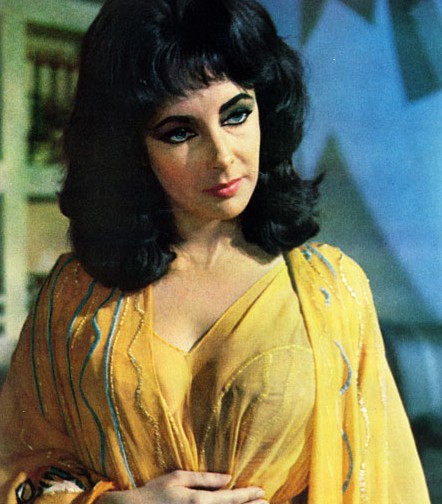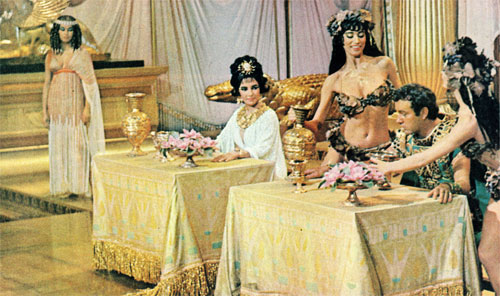Wit’s End: Losing Weight with Liz Taylor
In January, many of us pledge to shed excess weight, but as we all know, that’s easier said than done. After my first child was born, I found myself 40 pounds heavier and, after losing half, hit a plateau. The fitness books were filled with hideous prescriptions: counting calories, weighing food, and doing an unpleasant-sounding activity called “reps.”
But I did not want to do any of those things, and the books spooked me. Finally, I stumbled upon one called French Women Don’t Get Fat, by Mireille Guiliano. Its breezy tone assured me that I didn’t have to change my entire personality just to lose weight. A Frenchwoman wouldn’t dream of moving faster than a languid sashay, let alone do “reps.” How absurd!
It was the Francophilic pep talk that I needed, and it got results. But to address the steady upward creep of the scale in my 40s, I need more than the mental image of “being French.”
Enter the American movie star Elizabeth Taylor, one of the most celebrated beauties of all time. Unlike the prototypical Frenchwoman, she did get fat, especially during her marriage to politician John Warner from 1976 to 1982. Stuck at home in Washington, D.C. while Warner worked long hours, Taylor turned to comfort food (and other substances) for solace. “Eating became one of the most pleasant activities I could find to fill the lonely hours and I ate and drank with abandon,” she wrote later.
Taylor was publicly ridiculed for putting on weight in her 40s, but by her 55th birthday was en bonne forme and more glamorous than ever, having “dropped from 180-odd to 122 pounds.” Her 1987 book, Elizabeth Takes Off, tells the story of how she did it and, more importantly, of her extraordinary life. When I saw it in a used bookstore, I pounced on it like a frosted sugar cookie.
Reading the book is like having a vivacious aunt show up at your door, dripping in diamonds, to tell you if she can pull it together, so can you. Born in 1932, Taylor was nine years old when she made her first film, and she spent her childhood working on movie sets. Feisty from the start, in her early teens she told Louis B. Mayer to “go to hell” because she didn’t like the way he spoke to her mother. As a famous young star, she led a sheltered life, guarded by protective parents and studio bosses.
At 17, eager for independence, Taylor entered her first marriage, with seven more to come. Elizabeth Takes Off dwells fondly on her favorite husbands: producer Mike Todd, who died tragically in a plane crash one year after their 1957 wedding; and actor Richard Burton, with whom Taylor shared 11 films and married twice, in 1964 and 1975. She had three children and enjoyed motherhood so much that she adopted a fourth.
“I’ve always admitted that I’m ruled by my passions,” Taylor writes, explaining not just her many marriages but her love of parties, jewelry, and, yes, food. While today’s film actors subsist on soy crumbles and arugula, Liz was a meat-and-potatoes girl who loved burgers, steaks, mashed potatoes, and fries. She once asked a friendly ex-husband to visit her at Dulles Airport during a layover. “And maybe bring some leftover fried chicken. You do have some fried chicken around, don’t you?” Charmed, the ex-husband fried up some chicken and brought it to the airport with a side of fresh corn. And they lived happily ever after.
As she matter-of-factly describes a wild ride of films, marriages, divorces, hospitalizations, and dress fittings, Taylor is a likeable narrator. Despite having owned a giant rock called the Krupp Diamond, she seems an earthy, unpretentious woman with a zest for life. “I confess I love being surrounded by beautiful things and I love being looked after,” she writes (and I confess that I, and every woman strolling the aisles of a Bed, Bath & Beyond, love these things, too).
“When I gained weight, I just bought more clothes,” she writes sensibly. (Nodding.)
When anyone tried to help me, I’d say, ‘Look, I know what I’m doing. I’m going through a phase. I can’t diet until I’m ready, and if you push me, the minute you finish your lecture I will go in and have some hot fudge.’
The minute you finish your lecture, I will go have some hot fudge. I am so using that.
Taylor’s sometimes out-of-control life masked an inner strength, the mental toughness that comes through in her films. After a long run of overeating and other addictive behaviors, she took a hard look in a mirror and didn’t like what she saw. A stint at the Betty Ford Center addressed her alcohol abuse, and with a clear head Taylor realized that she had “been doing a lot of harm to [my] body for an awfully long time . . . . I had actually tossed away my self-respect.”
Husbandless and sober, she came up with her own personal plan for food and exercise. While the first half of Elizabeth Takes Off is autobiography, the second half describes her weight-loss regimen. But first, some general advice: “Get out that full-length mirror,” she instructs in her best bossy-aunt manner. “When you’re trying to diet, it’s no time to play games.” Taylor also advises to “look your best while losing.” She continues:
I know plenty of big ladies who are positively glorious-looking. They may wear a size sixteen or eighteen, but they’re always well groomed, neatly coiffed, and radiantly glamorous. Yet many dieters will throw on anything as long as it’s dark in color. Their philosophy is ‘I’m fat so it doesn’t matter how I look.’ Rubbish. It always matters how you look.
It always matters how you look. Strong words for my drawerful of ratty black yoga pants, Liz! But I hear you.
The diet itself is a curious artifact of the mid-’80s. Breakfast is fruit and whole-wheat toast or a bran muffin; lunches feature low-fat cottage cheese and skinless chicken breasts; and coffee is lightened with “a splash of skim milk.” For someone who liked her hot fudge sundaes, the menu is extremely disciplined, coming in at 1,000-1,200 calories a day. Desserts include a baked apple and something called an orange soufflé, made with “3 tablespoons low-cal margarine,” “2 packets artificial sweetener,” and grated zest.
Even at 30 years’ distance, it’s hard to criticize this diet, though it includes odd items like “barbequed squab” and not one, but two, types of “curried mayonnaise.” If Elizabeth Taylor happily consumed such foods on a tufted divan in her orchid-filled Bel Air estate, with a cabinet of acting awards to her right and an original Renoir to her left, planning her next charity ball on a gold phone, who are we to say Curried Mayonnaise #2 and a tray of raw broccoli is not quite up to par in 2020?
And anyway, you don’t read Elizabeth Takes Off for the recipes. It’s just inspiring to spend 200-plus pages with Aunt Liz, who hastens to add that her low-fat diet allows for occasional “pig-outs,” as she puts it with typical bluntness.
“Guard the assets you were blessed with like a miser,” Taylor instructs, but in the end, she is not unduly obsessed with beauty or weight. “Happily,” she wrote in her 50s, “God made me incredibly resilient and I was able to bounce back. In fact, when someone recently asked me what was my proudest accomplishment, I said with all sincerity: ‘Just being alive.’”
Featured image: Elizabeth Taylor in 1987 (Photo By John Barrett/PHOTOlink.net/MediaPunch/Alamy)
Debbie Reynolds and the Divorce of the Century
Originally published March 26, 1960.
In the 1950s, Debbie Reynolds and Eddie Fisher were one of Hollywood’s hottest couples — until Fisher had an affair with Elizabeth Taylor. In this article from March 26, 1960, Reynolds talked about how her highly publicized divorce affected her personally and professionally.
From its beginning, the courtship and marriage of Debbie Reynolds and Eddie Fisher was proclaimed “The Sweetest Love Story Ever Told.” So it was only natural that the shattering of the Fisher-Reynolds spun-sugar dream castle was as screamingly publicized.
The fact that the darling little couple had become a triangle was regarded in certain circles as the biggest domestic tragedy since Douglas Fairbanks Sr. parted from America’s Sweetheart, Mary Pickford. The Fisher-Reynolds split reached its climax when Debbie agreed—after a year of hesitation—to a quick divorce so her husband could embark upon his second marital venture, this time with Elizabeth Taylor. Even then, however, the triangle refused to go away. In terms of cold, hard cash, the ordeal made the two ladies involved far more valuable at the box office. The price tag of the discarded wife leaped to $125,000 a picture, then to $250,000. The sum demanded for the services of the new Mrs. Fisher zoomed from $500,000 to $750,000—then to $1,000,000. Miss Reynolds soon signed a similar contract, earning $1,000, 000 for three television appearances.
Eddie Fisher on the other hand, has temporarily fallen from the high estate of having his own TV show, to playing the night-club circuit and doing a role in M-G-M’s Butterfield 8, a vehicle which also stars Miss Taylor, while talks are being held about a new TV show for him.
During the time when Debbie and Eddie, once the nation’s most publicized newlyweds, were engaged in becoming the nation’s most highly publicized divorcees, Fisher and Miss Taylor did most of the talking. I’d read various statements attributed to Debbie, but it was my thought that if I could get her to give me some of her ideas about the a air at first hand, it would still be newsworthy.
I remembered a photograph of her taken a few days after the news broke that she and Eddie were having difficulties. I mentioned that photo to her now. I said, “You looked like a teen-ager someone had just kicked in the stomach.”
“I know the picture you mean,” she said. “I remember it very well. It was taken after I had my children out for an airing, and when I came home there were a lot of strangers in my house— reporters and photographers. I didn’t even know what had happened. Then they told me that my marriage seemed to be definitely on the rocks, but I still didn’t get it. I remember saying, ‘It’s unbelievable that you can live happily with a man and not know he doesn’t love you.” When they took that photo, I had just finished changing my babies. I wasn’t thinking about how I looked. My mind was completely on another subject. When I saw that picture, I was surprised to see a couple of diaper pins still attached to my blouse.”
“How old were you when you and Eddie were married?” I asked.
“Twenty-three.” she said. “I had lived at home with my mother until then, so I was extremely inexperienced. I had to grow up very fast. Too fast. I don’t think that’s the best way to grow up. I think it’s the hardest way. But you certainly can learn that way, and it’s very thorough.”
What she said next sounded like something she had said to herself many, many times—and that she would say it many limes more. “As long as you can accept your experiences and digest them and not let them make you bitter or cynical or assume that life is always going to be that way, you’ll be all right. But if you allow them to make you cynical and bitter…” Her voice trailed off.
Strength of Character
I said I thought it would have been easy for her to become bitter. “I wouldn’t
let me be,” she said. “All my life I’ve hated people who complain about their knee-aches or their backaches. All they had to do was look around them to see people having it more difficult than they. If you consider the road a lot of other people travel, you can say to yourself, “Mine isn’t that rough!’”
I said to her, “In spite of all the stress, your statements to the press always seemed sound and sensible.” I thought of one statement of hers in particular. She had just finished shooting It Started With a Kiss in Spain, and on her way home friends in California reached her on the long-distance phone and repeated to her some of the remarks made during an impromptu press conference held in Eddie Fisher’s dressing room in a Las Vegas hold.
Some of Elizabeth Taylor’s remarks &mash; she was also present — were reported to Debbie as follows: “Eddie and I intend to travel and see as much of the world as we can, and we would like to travel as man and wife… We respect public opinion, but you can’t live by it. If we lived by it, Eddie and I would have been terribly unhappy through all this. But I can shamelessly say that we have been terribly happy… I am literally rising above it.”
When questioned about the possibility that Debbie might refuse a divorce, Elizabeth Taylor had answered, “At first Debbie was very much hurt, but I think now the hurt has left and she will consent to Eddie getting a divorce here.”
“When I came home from Europe, people kept asking me, ‘Will you give Eddie a divorce or won’t you?’ said Debbie. “It wasn’t a new question. Eddie had asked me before, and I had said no. But when I was coming home on that plane and I knew there would be people waiting for me at the airport. I prepared a last statement on the subject. It was this: ‘The position in which I am placed makes it necessary for me to give my consent, but they would have gotten married anyway.’”
She stopped for a moment. “Seems like all I did last year was prepare last statements. It was a very pressured year for me. In that one year I had enough emotions to wear me out.”
“You came through all right,” I said.
“If I did, maybe it was because I never told an untruth,” she said. “Whatever I said about my emotions was honest. What I felt must have been obvious: I can’t hide what I feel, I’d be better off if I could. For that matter, I’d be better if I didn’t feel so much.
“I tried to do everything and think of everything as I will five or ten years from now. If I had talked or acted as I felt at the moment, I might have said and done wrong things. Unfortunately our situation became public property. If it hadn’t, I think the three of us could have dealt with it in a mannerly way, I would probably have said no to a divorce, and perhaps it all would have worked out differently. But because it was dumped in the public’s lap by the other people involved, I had no choice.”
I said, “Some of those who have watched you whirling around of late with an ‘I-don’t-care’ air have told me, ‘Debbie seems to be having herself a ball. She must be having a great time being a bachelor girl again.’”
She said, “Whether what happens to you is for the best or the worst depends on what you make of it. You can be miserable or you can be happy, I think I’m having a great time now, and I think I’ll keep right on doing that, because I have so much to be happy about. Before I was married,
I wanted children. Now I have two children. They are all anybody could ever want. I have a lovely home; my professional career is looking up, I can travel everywhere, and I have very dear friends. So inside I’m happy. I really am, but it has taken time to acquire that philosophy.”
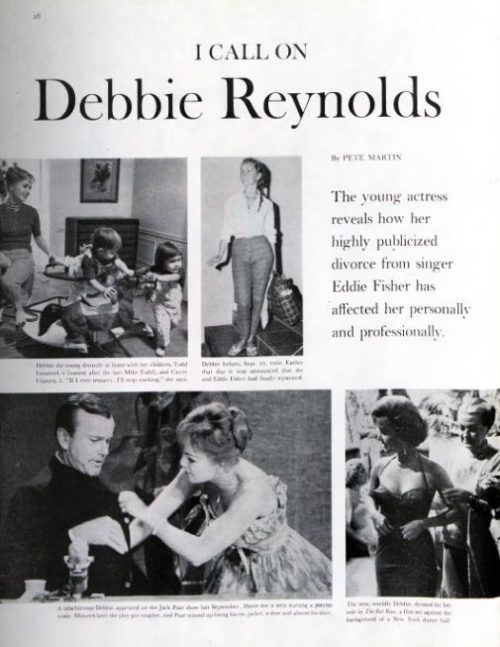
This article and other features about the stars of Tinseltown can be found in the Post’s Special Collector’s Edition, The Golden Age of Hollywood. This edition can be ordered here.
Elizabeth Taylor and The Cleopatra Spectacle
It probably killed the old “studio system” in Hollywood. The Taylor-Burton version of “Cleopatra,” originally budgeted for $2 million, wound up costing Twentieth Century Fox $44. The studio spent two-and-a-half years producing the film, which featured lavish sets, full-scale barges, an army of “extras,” and 65 costume changes for its star, Elizabeth Taylor.
The result was an extravaganza that clocked in at six hours in the director’s cut. The studio cut the film down to four hours for the premier and three hours for theatres, which still proved a little too long for public taste, even with all the big-name stars and the gaudy staging. “Cleopatra” may have been 1963’s top grossing film, but it only recovered half of the studio’s expenses that year. Twentieth Century Fox was brought dangerously close to financial collapse that it couldn’t breath easily until 1965 when it was saved by the highly popular “Sound of Music.”
If the movie was less successful as a theatrical release, it was a stunning triumph as a tabloid sensation. The romance that sprang up between Taylor and co-star Richard Burton made “Cleopatra” the object of continual attention from the media. Writing about his work in producing the movie, Walter Wanger said “I have been told by responsible journalists there was more world interest in Cleopatra… than in any other news event of 1962”—a considerable claim in the year of the Cuban missile crisis.
Several actresses had been suggested to play the title, including Dorothy Dandridge, Joanne Woodward, Joan Collins, Marilyn Monroe, Kim Novak, Audrey Hepburn, Sophia Loren, and Susan Hayward.
But Wanger wrote that Taylor had been his only choice since the project began. And the studio’s faith in her was so great, it continued to sink millions into a picture that probably would have been cancelled if it had another leading lady.
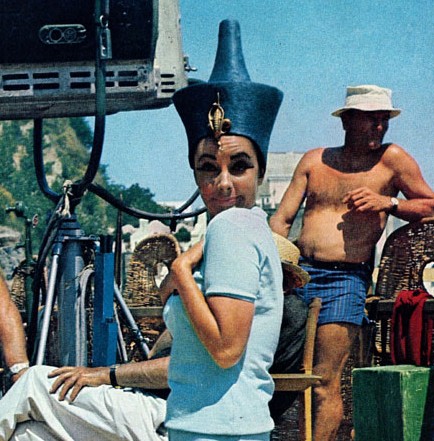
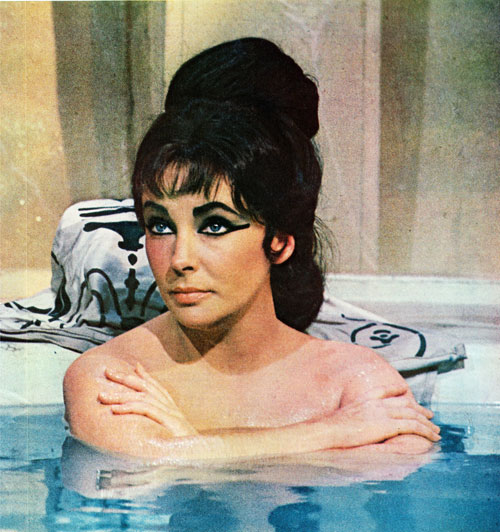
See also:
Remembering Elizabeth Taylor
Elizabeth Taylor: AIDS Activist
Elizabeth Taylor: AIDS Activist
By the time Elizabeth Taylor made her last appearance in the Post, she was no longer known just for her screen roles—or her myriad marriages. She’d founded AmfAR, the American Foundation for AIDS Research. It was this role that, many say, truly fulfilled her. In 1987, she spoke directly to the Post’s Holly G. Miller about her activism.
Post: What prompted your interests and efforts on behalf of AIDS?
Taylor: First, I became aware of the fact that there was a new and very serious disease that was destroying many young people in the arts community at the very prime of their lives. Second, I had a strong sense of compassion for these people for whom literally nothing could be done. And finally, I was outraged that nothing was happening, that no one seemed to care—and then I realized that if I didn’t become involved, I had no one to blame but myself.
In addition to becoming personally involved, she engaged President Reagan in the battle against AIDS, and made sure that, in the final years of his presidency, HIV remained on his agenda. In doing so, she brought the formerly shunned disease into America’s mainstream political discussion.
Post: If you could bring one message to the American people about AIDS, what would it be?
Taylor: We are in this together! As President Reagan has said, “AIDS affects all of us”—as he said, “AIDS calls for urgency, not panic—compassion, not blame—understanding, not ignorance.”
Post: How have you gone about your fund-raising efforts?
Taylor: By talking about the importance of this issue, by reaching out to encourage the involvement of friends, by challenging our leaders and others to be involved, by setting up the American Foundation for AIDS Research, and by personal appeals and appearances on behalf of this issue.
Over the course of her 70-year career, Taylor entertained us, dazzled us, and, in the end, did her best to take care of us.
See also: Elizabeth Taylor, Leading Lady of the Sixties
Donate to AmfAR today at www.amfar.org.
Remembering Elizabeth Taylor
When Elizabeth Taylor wrote about her early career in “The Role I Liked Best…” (The Saturday Evening Post, September 24, 1949), she was just 17 years old, but had already starred in 12 motion pictures.
I literally grew into my favorite role—the part of Velvet in the picture National Velvet. I started to qualify for it as a small child by learning to love horses, and began riding at the age of three. When I was four, my godfather gave me a field horse, and soon I started jumping and steeplechasing. Later, I read Enid Bagnold’s novel, “National Velvet,” and began to dream of playing Velvet in a movie.
So when I reached a relatively ripe thirteen and heard tbat M-G-M planned to produce a picture based on this story, I went to Producer Pan Berman and told him bow much I wanted the role.
“But you’re too small and frail,” he said.
“I’ll grow,” I promised.
Afterward mother wondered why I had said tbat. “You know you haven’t grown a quarter inch in three years,” she pointed out.
“It wasn’t necessary then,” I said. “Now it is.” Until then, I had eaten like a bird. But after making that promise I started packing away steaks and chops like a lumberjack. In three months I grew about three inches and gained weight besides. Maybe Nature poked a helpful hand into my build-up program, but I like to think I did it all myself. Anyway, I got my favorite role—and King Charles.
King Charles was supposed to be a mean horse, and only his owner and his trainer were allowed to ride him. But I managed to win his trust by visiting him day after day. Then I persuaded the studio to buy him for the picture, and finally King Charles was presented to me as a birthday present.
By the time another 17 years had passed, she had left such ingenue roles far behind her to win the 1967 Academy Award for Best Actress playing the bitter, destructive Martha of “Who’s Afraid of Virginia Woolf.”
Next: Taylor’s Most Passionate Role, as an AIDS Activist
Classic Covers: Leading Ladies of the ’60s
This 1966 cover is one of several I’ve unearthed to answer the burning question: “Which celebrities appeared on the covers of The Saturday Evening Post?” Next week, great celebrity MEN like Newman, Redford, Connery… But this week it’s sizzling sixties sirens!
Elizabeth Taylor – December 3, 1966
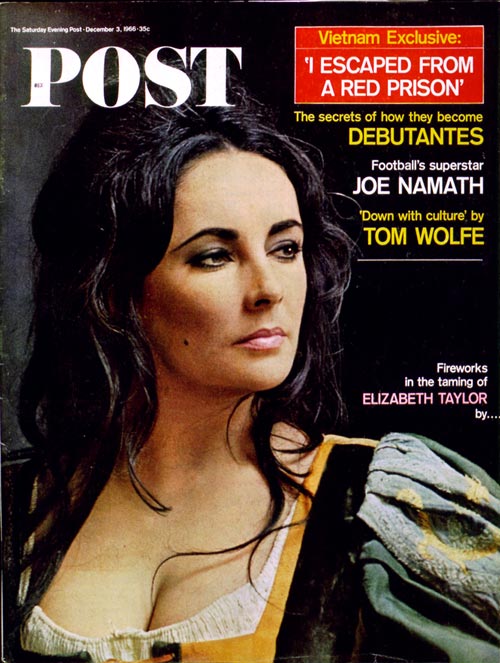
Elizabeth Taylor may have been a shrew on the December 3, 1966 cover, but she was also a stunner. She and Richard Burton were starring in The Taming of the Shrew. The Paul Ronald photo gives credence to those who argue she was the most beautiful screen actress of all. To my surprise and delight, the cover folded out to show the man attempting to tame her (Burton as Petruchio). Well, it certainly never happened in real life.
Sophia Loren – October 21, 1967
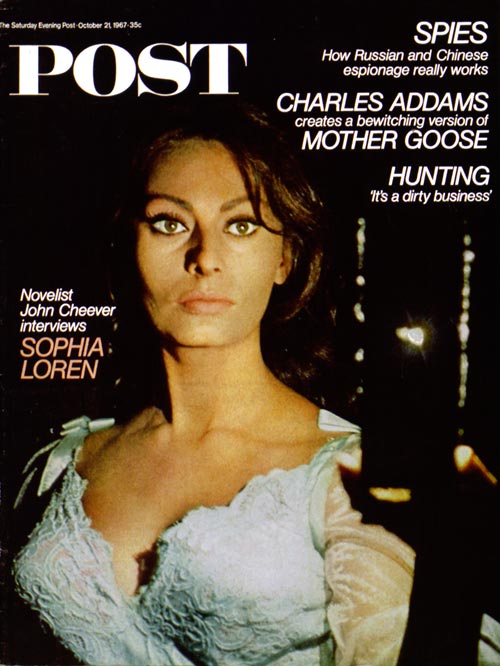
Just when you stick your foot in it and assert that Liz was the greatest screen beauty ever, you run across a gorgeous cover of Sophia Loren from 1967. The battle rages on. The movie star had a rough beginning, “even for a poor Neapolitan,” wrote John Cheever in the accompanying article. “She was seven years old when the three-year of bombardment of Naples began during World War II, and she and her mother suffered the hazards of poverty and war.” Forty-three years later, she’s still gorgeous.
Ann-Margret – May 4, 1963
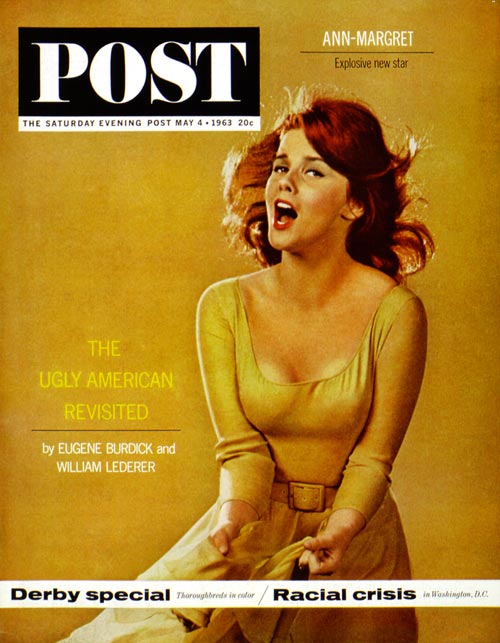
Looking sassy, sexy and joyful all at once is Ann-Margret, an “explosive new star.” Her rise to Hollywood fame was considered lightning fast. “At 22, having emerged from nowhere by way of Sweden and Illinois, Ann-Margret has worked the film town’s official chroniclers into a froth of admiration,” wrote Dean Jennings. As ingenuous as the young star was, she planned “to be the girl who sustains, year after year.” We’re delighted she succeeded.
Faye Dunaway – September 7, 1968
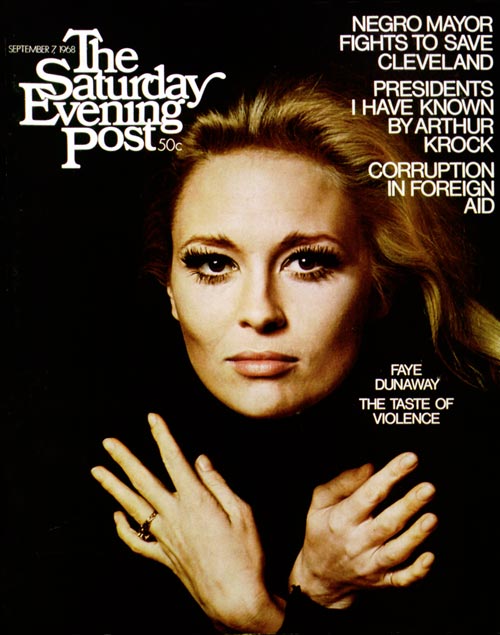
I have been known to rue the day photography replaced art and illustration on the covers of The Saturday Evening Post, but a photo like this reminds even a curmudgeon like myself that photography is an art form, too. The beautiful star was nominated for Best Actress for Bonnie and Clyde from the year before.
Julie Andrews – January 29, 1966
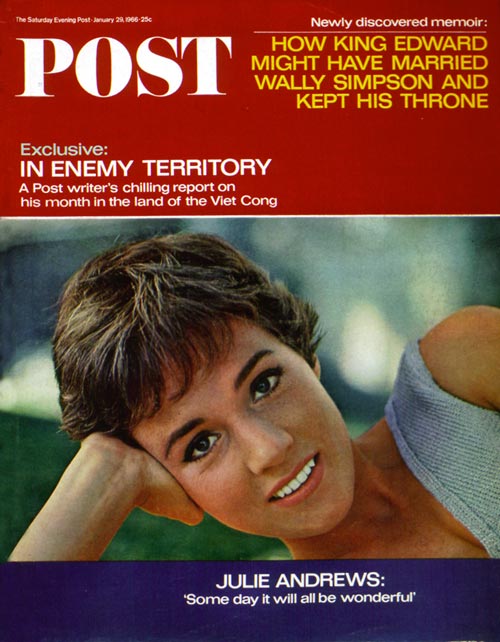
I love the fresh-faced Julie Andrews of this 1966 cover. She was a long way from the Mary Poppins of only a couple of years before, starring in a cold-war themed Hitchcock movie. With her in “Torn Curtain” was Paul Newman (who’ll be one of our “leading men” next week). She was the first to make fun of her squeaky clean image. When Hitchcock complained during a scene, “That light is making a hell of a line over her head,” she responded with hands primly on hips, “That’s my halo.” Okay, no halo, but she certainly had a radiance.
Brigitte Bardot – May 8, 1965
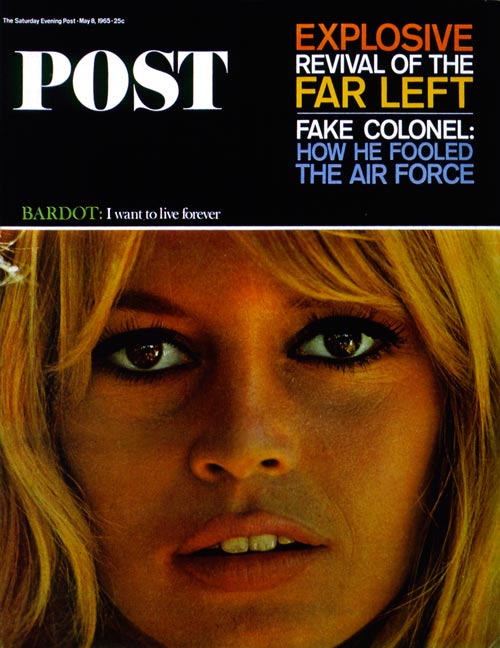
“For people like me,” Bardot was quoted as saying, “there is no place left to hide.” The sex kitten was still a hot property at the ripe old age of thirty. According to the article, “police almost lost control of the mob when she got off the plane in Mexico City to assume her part in Viva Maria! Being hounded by the paparazzi isn’t a new thing—the alluring actress was brutally pursued by photographers. She retired less than ten years later and became an outspoken advocate for animal rights.
Next week: The masculine celebrities of the sixties and seventies
